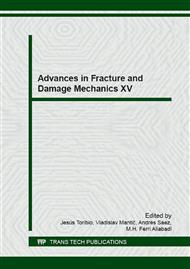p.273
p.277
p.280
p.284
p.288
p.293
p.297
p.301
p.305
Temperature Robust PCA Based Stress Monitoring Approach
Abstract:
In this paper, a guided wave temperature robust PCA-based stress monitoring methodology is proposed. It is based on the analysis of the longitudinal guided wave propagating along the path under stress. Slight changes in the wave are detected by means of PCA via statistical T2 and Q indices. Experimental and numerical simulations of the guided wave propagating in material under different temperatures have shown significant variations in the amplitude and the velocity of the wave. This condition can jeopardize the discrimination of the different stress scenarios detected by the PCA indices. Thus, it is proposed a methodology based on an extended knowledge base, composed by a PCA statistical model for different discrete temperatures to produce a robust classification of stress states under variable environmental conditions. Experimental results have shown a good agreement between the predicted scenarios and the real ones
Info:
Periodical:
Pages:
288-292
Citation:
Online since:
September 2016
Authors:
Keywords:
Price:
Сopyright:
© 2016 Trans Tech Publications Ltd. All Rights Reserved
Share:
Citation:


